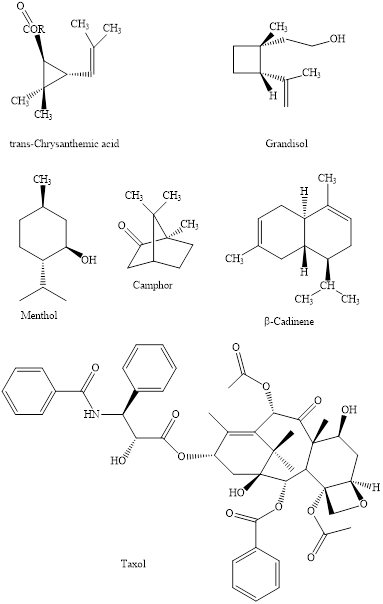
(a)
Interpretation:The natural products indicated should be identified as either chiral or achiral.

Concept introduction:
The enantiomers are identical chemical compounds that have a mirror-image relationship to each other while diastereomers do not hold mirror image relationships. The former are chiral and optically active while the latter can be chiral or achiral.
Four kinds of symmetry elements that may be present are tabulated as follows:
Presence of any symmetry element makes molecule achiral and optically inactive.
(b)
Interpretation: The three molecules that represent enantiomers of

Concept introduction: The enantiomers are identical chemical compounds that have a mirror-image relationship to each other while diastereomers do not hold mirror image relationships. The former are chiral and optically active while the latter can be chiral or achiral.
Trending nowThis is a popular solution!

Chapter 5 Solutions
Organic Chemistry: Structure and Function
- Consider 1-bromopropane, CH3CH2CH2Br. (a) Draw a Newman projection for the conformation in which CH3 and -Br are anti (dihedral angle 180°). (b) Draw Newman projections for the conformations in which - CH3 and -Br are gauche (dihedral angles 60° and 300°). (c) Which of these is the lowest energy conformation? (d) Which of these conformations, if any, are related by reflection?arrow_forwardOne of the isomers of 1,2,3,4,5,6-hexahydroxycyclohexane, called myo-Inositol, acts as a growth factor in both animals and microorganisms. Draw the most stable chair conformation of myo-Inositol (Note: account the wedge and dash projection). Draw the most stable cis-trans stereoisomer of myo-Inositol. OH HO ОН HO "OH ОНarrow_forwardConsider the reaction between (1S,3S)‑1‑chloro‑3‑methylcyclopentane and methanethiol in the presence of sodium hydroxide. (a) Draw the organic product and clearly indicate stereochemistry by showing the hydrogen on the chirality centers and using wedge and dash bonds. (b) Then analyze the stereochemistry of the product. racemic chiral achiral (1R, 3S) (1R, 3R) (1S, 3S)arrow_forward
- 2A2: Apply the concepts of stereocenters, chirality, asymmetry, and the CIP Rules to label enantiomers/ diastereomers and R/S or E/Z absolute configurations. These two (2) structures have ambiguous configurations. Provide a wedge and dash structure for the indicated configurational isomer. In your response, keep the overall structural orientation the same as given. In addition, label all alkenyl FGs as either E or Z in both structures by showing your work. & H3 C CH3 (R, R, R,) H3CO. H3CO CH3 (S, S, S) CH3 OCH 3 OCH 3arrow_forward9. For 3-fluoro-2-methylpentane, draw the Newman projection for the: (a) lowest energy conformation; (b) highest energy conformation, looking down the C-2 and C-3 bond length. You can use the following as shorthand: Me = methyl; Et = ethyl. (a) (b)arrow_forward(a) Describe the molecular geometry expected for 1,2,3-butatriene (H2C=C=C=CH2). (b) Two stereoisomers are expected for 2,3,4-hexatriene (CH3CH=C=C=CHCH3). What should be the relationship between these two stereoisomers?arrow_forward
- The compounds shown here consist of a cyclohexane ring, a methyl group, and a hydroxyl group. Which one shows cis-trans isomerism and has two stereocenters?arrow_forward5. For the molecules below assign the stereochemical configuration of the selected tetrahedral carbon chiral centers (R, S or N (not a chiral center)) and the alkene (E, Z or N (not a stereocenter)) that are indicated by the arrows (note that you do not have to assign the configuration of every chiral center in the molecule). If the atom in question is not a chiral center or is not a stereocenter circle N for neither. b) RSN RSN HO" RSN EZ N RSN НО. H₂N HO HO OH HO OH RSN RSN CH3 НИ H3 CH₂ RSN RSN RSN EZ N RSNarrow_forwardassign the stereochemical configuration of the selected tetrahedral carbon chiral centers (R, S or N (not a chiral center)) and the alkene (E, Z or N (not a stereocenter)) that are indicated by the arrows (note that you do not have to assign the configuration of every chiral center in the molecule). If the atom in question is not a chiral center or is not a stereocenter circle N for neither.arrow_forward
- Using solid and dashed wedges, draw the structure of (1S, 2S, 4R, 5R)-1,5-dibromo-2,4- dichlorocyclohexane, then draw the most stable conformer.arrow_forwardFor the following molecules, draw all possible stereoisomers using line-angle formulas with wedge/dash notation. Label the stereocenters as R or S. Indicate which ones are enantiomers and which ones are diastereomers. (Remember: there are 2 stereoisomers possible for a molecule with n chiral centers) (A) (B) (C) (1 chiral center) Br OH (2 chiral centers) CI OH CH3 (3 chiral centers)arrow_forwardConsider 1-bromopropane, CH3CH2CH2Br. (a) Draw Newman projections for the conformations in which -CH3 and -Br are gauche (dihedral angles 60° and 300°).arrow_forward
